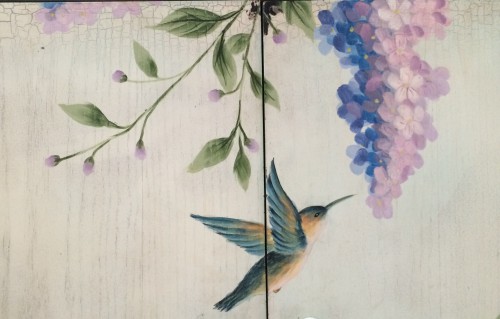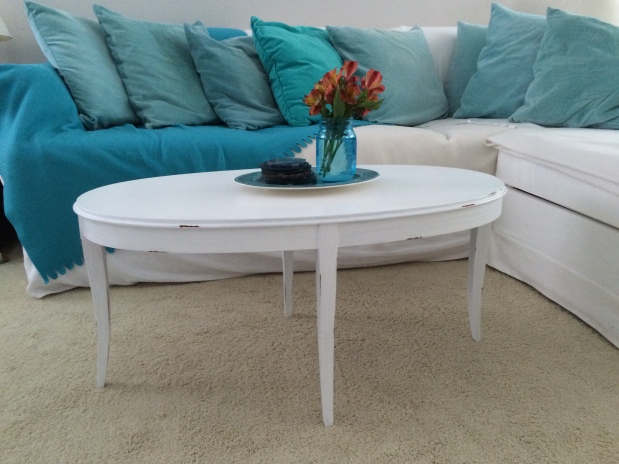How a shabby chic furniture refurbisher took an unexpected detour and found a one-of-a-kind treasure with sentimental value.
My heart fluttered when I saw it. A vintage cabinet that had been beautifully hand-painted with a rendering of a hummingbird hovering among wisteria vines and lilacs. This work of art was already perfect—no refurbishing required—and it instantly reminded me of my maternal grandmother who had adored hummingbirds. I had to have it!
I’d popped into this thrift store while I was running my weekend errands, just for a quick browse to see if they had any vintage furniture pieces that might lend themselves to a white-washed, chippy paint, shabby chic look.
After hunting among a limited selection of boxy media cabinets from the 1980s for my next furniture project, I’d almost given up. Then I spotted a small vintage wooden magazine rack that I could immediately imagine refurbished with white paint. I picked it up to get a closer look, and that’s when my eyes strayed down to the cabinet upon which it had been placed.
The top and sides of the cabinet had been painted a sage green with chipped corners, which was nice. But the front was the real surprise. It had been painted a creamy color, and then covered with a delicate study of flowers and a single hummingbird—all done in pale lavenders, blues, greens, and pinks, which were all my grandmother’s favorite colors. (I stood there thinking: Are you seeing this, Grandma?) I have a quilt at home that was handmade by my aunt in fabrics of the very same hues, which I love, too.
 I found a price tag taped to the inside of the cabinet’s door. It had been priced at $124, then had been marked down to $99, and now had a 40% off sticker taped over that. Yay! Why hadn’t this thing of beauty sold at $124? It was worth twice that. Never mind, it was mine now!
I found a price tag taped to the inside of the cabinet’s door. It had been priced at $124, then had been marked down to $99, and now had a 40% off sticker taped over that. Yay! Why hadn’t this thing of beauty sold at $124? It was worth twice that. Never mind, it was mine now!
I couldn’t see a clerk anywhere in sight, and I didn’t dare leave the cabinet for a second for fear someone else might nab it. (Did I already mention that it matched my heirloom quilt exactly?) So, fool that I am, I dragged the cabinet by myself to the back of the store, and stood guard beside it while trying to flag down a clerk to help me.
A clerk eventually spotted me and rang up my purchase. As he was helping me load the the cabinet into the back of the car, he told me, “You have impeccable taste. I can’t believe someone didn’t buy this cabinet sooner.” I replied with a breezy, “It’s beautiful, isn’t it?” (Inside I was thinking: “Score!!”)
Once I got it home, my hummingbird cabinet didn’t need more than a gentle cleaning with a moist baby wipe. Otherwise, it’s chippy paint finish is perfect as it is, and looks quite at home in my shabby chic apartment as a storage cupboard for my art supplies. A functional and beautiful treasure with an aged patina…a perfect combination.
A Tale of Two Hummingbirds
There is another hummingbird that figures into this story. Sure, painted furniture is a key component of shabby chic style, so sourcing one-of-a-kind painted furniture pieces like this falls within the parameters of a shabby chic treasure hunt. But…the real reason I fell in love with this cabinet was because it reminded me so much of my grandma. It was almost like she’d been shopping with me and noticed it at the exact moment that I did.
Grandma loved hummingbirds. For as long as I can remember, she kept hummingbird feeders hanging outside her kitchen window and loved to to watch them fluttering about those feeders with their jet-speed wings.
Grandma received a lot of gifts over the years that carried the hummingbird motif. She even bought kleenex boxes that were decorated with hummingbirds. One of those kleenex boxes figures into this story, too.
My aunt once made a gorgeous watercolor quilt — a quilting style that looks more like an impressionist painting than a patterned quilt. This quilt was crafted with floral fabrics of purple, blue, pink and green, with a plain, cream-colored circle at the center of the design. After my aunt hung the quilt on the wall, grandma decided it needed something in the center. One day while my aunt was out, grandma cut out a hummingbird image from her kleenex box and pinned the little bird to the center of that quilt.
 Days later, my aunt noticed the little bird hovering at the center of her quilt and said, “Oh, look! Where did he come from?”
Days later, my aunt noticed the little bird hovering at the center of her quilt and said, “Oh, look! Where did he come from?”
Grandma smiled and said, “He just needed to be there.”
 After grandma died two years ago at the ripe old age of 100, my aunt had to pack up the house and let it go. Knowing how much I love that quilt, she gifted it to me. After she’d washed it and was packing it up for me, I asked her if I could also have the little cardboard hummingbird that Grandma had pinned to its center.
After grandma died two years ago at the ripe old age of 100, my aunt had to pack up the house and let it go. Knowing how much I love that quilt, she gifted it to me. After she’d washed it and was packing it up for me, I asked her if I could also have the little cardboard hummingbird that Grandma had pinned to its center.
“Of course,” she said, “they belong together.” And she tucked it into my suitcase with the quilt.
















